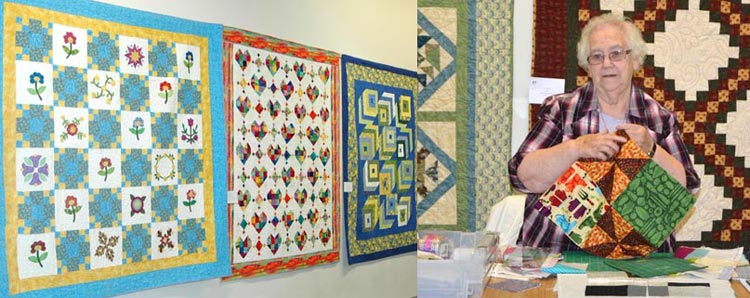Thurles Library’s “All Hands Together” Exhibition
As part of the Bealtaine Festival, Thurles Library (The Source, Cathedral Street, Thurles) are currently and kindly hosting an amazing exhibition in the Source Library & Arts Centre Gallery.

Ms Phyl Dwyer, Turtulla, Thurles, demonstrates the ancient art of ‘Quilting’.
This exhibition, featuring the skills of the ‘Spike Quilters of Littleton’ and entitled “All Hands Together”, is open free to the public until Tuesday May 30th next; to be viewed in conjunction with the opening hours of Thurles Library.
The Spike Quilters of Littleton.
‘Spike Quilters’ are a group of compatible and inclined women aged between 15 years & 90 years, who meet together on a monthly basis to undertake and learn the ancient art of patchwork. With their monthly meeting place in The Muintir na Tíre Hall, Littleton, Thurles, Co. Tipperary; here the elderly share the considerable knowledge they have acquired in the art of ‘Quilting’ with their younger counterparts. Meetings are held in the hall from 10.30am to 4.00pm on the appointed day, (Usually second Sunday of every month), with each individual working on their own project, be it a ‘Wall-Hanging’ or a ‘Quilt’. Here colours are discussed, ideas are exchanged, progress encouraged and all over numerous cups of tea and chat. Guest teachers are a regular feature of these workshops, initiating new ideas and up skilling.
The Patchwork Quilt.
A patchwork quilt is a multi-layered textile in which the top layer consists of pieces of fabric sewn together to form a design. Originally, this was to make full use of accumulated left-over or salvaged scraps of fabric.
As stated, the quilt is usually formed of three individual layers; the patchwork quilt top; a layer of insulation wadding (batting), and a layer of backing material. Same may be used as throws, wall hangings, table runners or even tablecloths.
- The art of quilting has a long history, first evidence of which appears back in the 35th century BC, with an ivory carving, found in the Temple of Osiris, at Abydos near the modern Egyptian towns of el-‘Araba el Madfuna and al-Balyana, during 1903 and currently in the collection of the British Museum. This carving features the king of the Egyptian First Dynasty wearing a cloak which appears to be quilted.
- Attributed to the 1st century BC – 2nd century AD, we have a textile in the form of a quilted linen carpet found in a Mongolian cave tomb which today is housed in the collection of the Leningrad Department of the Institute of Archaeology of the Academy of the Sciences of the Union of the Soviet Republic.
- Made circa 1400 AD, we have a Milanese ivory carving of the Holy Family depicting the ‘Flight into Egypt’, showing Joseph wearing a coat quilted in a diamond pattern. Same is housed in the collection at the Victoria & Albert Museum, United Kingdom.
- In 1547, the Inventory of King Henry VIII of England lists “Quyltes” and “Coverpointes” among the bed linen. The inventory describes the quilts as made of “holland cloth” (linen or cotton), “bockeram” (cotton),” or various types of silk including “sarceonett”, “tapheta,” and “lynnen.” Some of these quilts would have been given to lesser members of Court, either as a sign of favour or as a gift. Indeed, the young 16 year old Catherine Howard, fifth queen (for three months only) of Henry VIII, was given a gift of two dozen quilts, sometime before being beheaded, on the grounds of treason, and for supposedly committing adultery, while married to Henry.
Now thankfully, due to the ‘Spike Quilters of Littleton’ and Thurles Library; in 2017, the craft of quilting can be seen to continue, with this exhibition showcasing work to most impressive effect.
When shopping in Thurles over the next 10 days, please do take a coffee break and go visit this exhibition of splendour and truly talented aptitude.

Leave a Reply